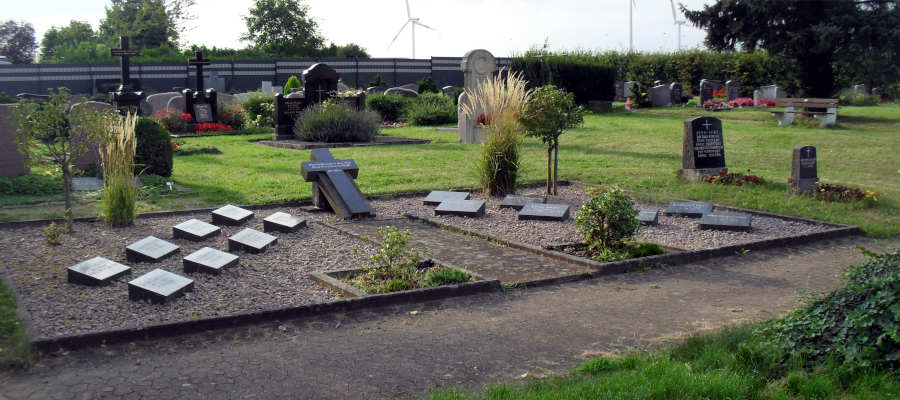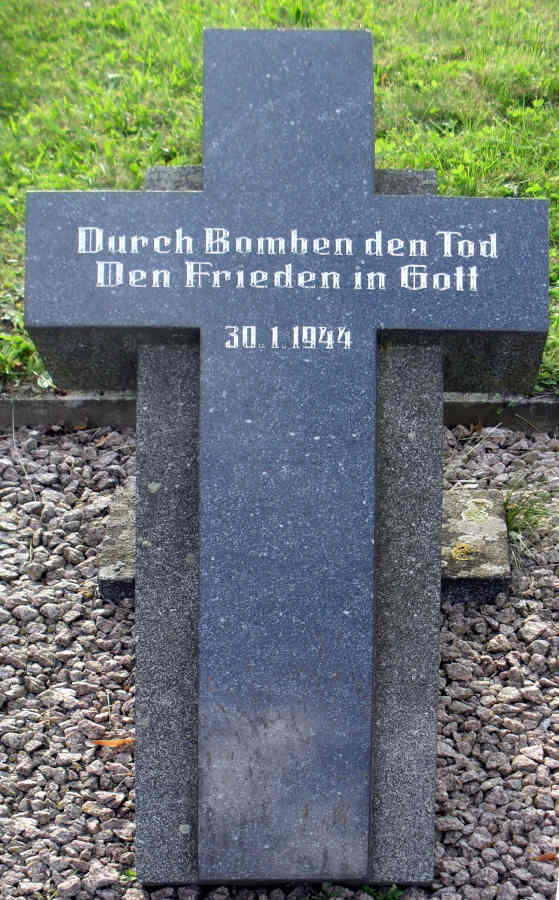"Since the winter of 1943/44, Braunschweig was a constant target of the Allied Air Force. On January 30, 1944, the US Air Force flew a daytime raid on the city with 599 B-17 bombers and 635 accompanying fighter planes. The targets were the industrial areas in the south, but because of the cloud cover, most of the bombs fell on the southern residential areas in Braunschweig and the surrounding rural areas, including Broitzem, Gartenstadt, Leiferde, Melverode, Rautheim, Riddagshausen, Salzdahlum and Geitelde. From 12 noon onwards, Geitelde was hit hard in two waves.
On the Hennecke property alone, seven family members and three visitors from Rüningen, Thiede and Steterburg were killed, and five on the Hogrefe farm, including two Poles. Three of Hennecke's children were saved. On September 16, the farmer's daughter Dorothee Ehlers picked up the detonator of a bomb while digging potatoes, which then exploded. She was seriously injured and died. A stranger was found near in a bomb crater.
Geitelde had about 550 inhabitants at the time.
Five large and 13 smaller fires had to be extinguished. The fire-fighting operation lasted until midnight. All clearing work was done by hand because there were no machines available. There were major damages to buildings and fields, and almost all roofs had to be temporarily covered afterwards. 78 bombs and aerial mines fell on the village, as well as countless incendiary canisters and phosphorus bombs. 320 large bomb craters were counted in the fields.
All buildings belonging to the Heinemann, Quent, Miss Haase, Hennecke and Stüwig families and the school were completely destroyed, as were individual buildings belonging to the Weule, Hogrefe, Wolter, Ziehr, Grabenhorst and Lütge families. All buildings in Geitelde had roof damages and some had been severely damaged by fire.
The access roads were blocked by around 78 bomb craters, so that fire brigades and ambulances had to remain at the edge of town. It was not until 3 p.m. that the first portable pump from the Bad Harzburg fire brigade, carried through gardens, and could be docked at the fire pond. The Geitelde fire pump was broken. Explosive bombs had fallen into the pond and stirred up mud that had broken the pump.
The Braunschweig - Derneburg railway line was destroyed.
The Geitelders, especially the roofers and other craftsmen, had a hard time to repair the most urgent damages at least temporarily. About 70 large bomb craters in the village were immediately filled with the resulting rubble, 290 of 320 craters in the fields were filled up with the help of caterpillars until July 1944. The required 2846 liters of diesel oil were provided by local farmers. The last craters were filled up in 1946.
Up to 49 Russian prisoners of war along with three guards and a chief overseer from the prison camp near Beddingen were also deployed to clean up.
As a result of the severe destruction of the school, teachers Kleemann and later Fritz Horn had to temporarily teach up to 156 children of all ages in a makeshift building, without school books or writing materials, using the backs of old rolls of wallpaper."
The text is an extraction and was taken from the book "Geitelde - Streiflichter aus einem braunschweigischen Dorf" written by Otto Dieling and Rolf Siebert.
The whole book (German version) can be read here
Translation of the text was done by Lost Ancestors.
|







